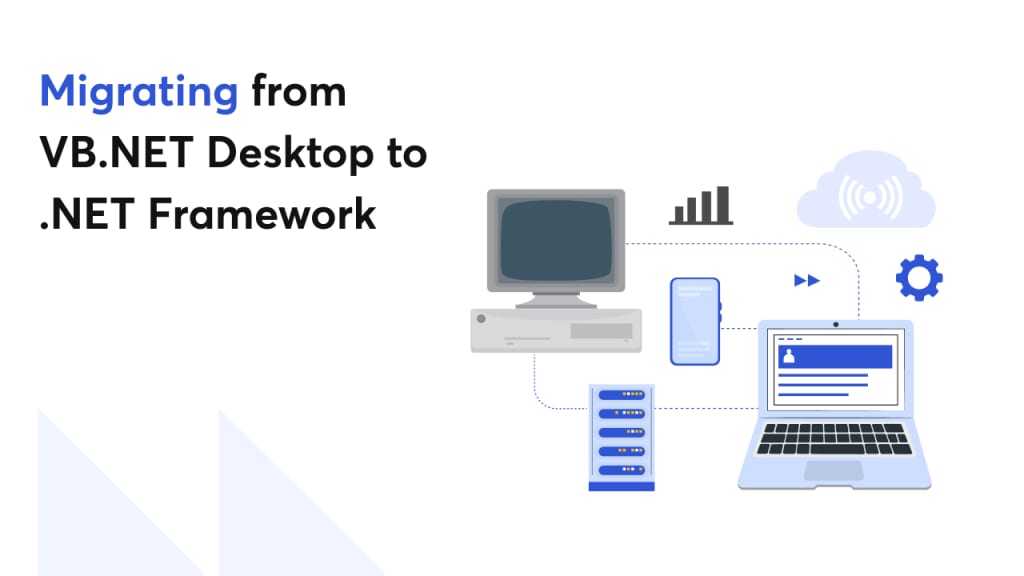Migrating from VB.NET Desktop to .NET Framework: A Comprehensive Guide
Unlocking the Potential: A Step-by-Step Guide to Migrating from VB.NET Desktop to .NET Framework

Introduction:
In the world of software development, staying up-to-date with the latest technologies and frameworks is crucial for maintaining a competitive edge. If you have an existing VB.NET desktop application and are looking to modernize it by migrating to the .NET Framework, this blog is for you. We will explore the process of migrating from VB.NET desktop to .NET Framework, highlighting key considerations and providing code examples along the way.
Understanding the Migration Process
Before you take Google and search for a desired VB.NET Desktop to .NET Framework Agency, you need to understand the application modernization process, albeit every process is different from each other. Like here we have explained the process specific to VB.NET Desktop to .NET Framework. Let's explore them one by one.
Assessing the Existing Application:
Before starting the migration process, it's essential to evaluate your existing VB.NET desktop application thoroughly. Identify the functionalities, dependencies, and components that need to be migrated. This analysis will help you plan the migration process more effectively.
Upgrading VB.NET Code:
One of the first steps in the migration process is upgrading the existing VB.NET code to be compatible with the .NET Framework. The .NET Framework provides a set of tools and utilities to assist in this process. For example, the Visual Basic Upgrade Wizard helps convert VB6 code to VB.NET. Similarly, the Visual Studio IDE provides a code converter to assist with code upgrades.
Refactoring and Rebuilding:
During the migration, it's essential to refactor the codebase to align with the best practices and patterns of the .NET Framework. This step involves restructuring the code, optimizing performance, and enhancing maintainability. Additionally, you may need to rebuild certain components or modules to leverage the full potential of the .NET Framework.
Addressing API and Library Changes:
The .NET Framework introduces new APIs and libraries, which might differ from the ones used in the VB.NET desktop application. Carefully analyze these changes and modify the code accordingly. Replace any deprecated or obsolete APIs with their equivalent .NET Framework counterparts.
Testing and Debugging:
Testing and debugging play a crucial role in ensuring a successful migration. Develop a comprehensive testing strategy to validate the functionality and integrity of the migrated application. Use debugging tools provided by Visual Studio to identify and resolve any issues that arise during the migration process.
Code Examples:
Let's take a look at a couple of code examples to illustrate the migration process:
Migrating UI Controls:
In VB.NET desktop, you might have used Windows Forms controls. To migrate to the .NET Framework, you can replace them with their corresponding WPF controls. For example, you can replace a Windows Forms Button control with a WPF Button control as shown below:
VB.NET Desktop:

.NET Framework:

Upgrading ADO.NET Code:
If your VB.NET desktop application uses ADO.NET for database operations, you can upgrade it to use the ADO.NET classes provided by the .NET Framework. For example, you can replace the OleDbConnection with SqlConnection and OleDbCommand with SqlCommand:
VB.NET Desktop:

.NET Framework:

Conclusion:
Migrating from VB.NET desktop to the .NET Framework opens up a world of possibilities for modernizing your application. By following a systematic approach, assessing the existing codebase, upgrading the code, addressing API changes, and thorough testing, you can successfully migrate your application. Leverage the power of the .NET Framework to enhance performance, maintainability, and future scalability of your application.
Remember, the migration process can be complex and time-consuming, but with careful planning and attention to detail, you can achieve a seamless transition. Embrace the benefits of the .NET Framework and propel your VB.NET desktop application into the future.
About the Creator
Kevin Bhut
I am a young entrepreneur with an ambition to transform businesses with tech advent. I am the Co-Founder and CEO of Codzagarage, a leading application modernization agency in the USA. Visit us at codzgarage.com






Comments (1)
Thanks for sharing